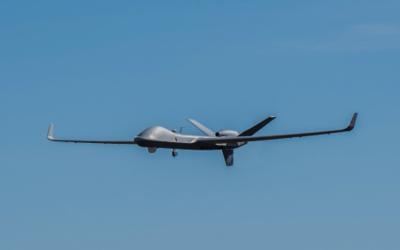Fri, Sep 22, 2017
Unmanned Flight Through Civil Airspace Covers 1,075 Nautical Miles
On August 30th, General Atomics Aeronautical Systems flew its first test flight out of its new Flight Test and Training Center (FTTC) facility in Grand Forks, North Dakota. The GA-ASI Block 5 Predator B/MQ-9 Remotely Piloted Aircraft (RPA) flew a round-trip of approximately 1,075 nautical miles. This was the longest transit flown by a Remotely Piloted Aircraft (RPA) in Class A civilian airspace under a Certificate of Waiver or Authorization (COA) granted by the FAA. The COA authorized the Block 5 MQ-9 to fly in airspace managed by air traffic controllers without the requirement of utilizing a “chase” airplane.

“This flight signified several ‘firsts’ for us and for the industry,” said David R. Alexander, president, Aircraft Systems, GA-ASI. “As we continue to demonstrate our ability to fly RPA safely alongside passenger planes, we further our efforts towards certifying the aircraft and increasing their mission possibilities in Class A civilian airspace.”
Additionally, this was the first time an unmanned aircraft operated through multiple spot beams of a High-throughput Satellite (HTS). HTS is a new generation of satellites providing higher data throughput and interference mitigation. As an RPA’s mission distance increases, it needs to be able to transition seamlessly from one satellite beam to another. For this flight, the Block 5 MQ-9 communicated with two HTS beams.
GA-ASI announced the completion of a new permanent hangar for its FTTC in Grand Forks on August 21st. The new hangar replaces the temporary facility that had been in operation since June 2016. It houses GA-ASI operational hardware, including RPA and ground control stations, as well as offices and conference rooms. In addition to conducting flight tests, the FTTC operation operates an office building near the University of North Dakota campus that features classrooms and a Predator Mission Aircrew Training System for accomplishing the academic and simulator segments of training.
(Image provided with General Atomics news release)
More News
Airplane Bounced About 3 Ft Then Touched Back Down And Then, With No Brakes Applied, The Airplane Began Veering To The Left Analysis: The pilot entered the airport traffic pattern >[...]
Aero Linx: British Microlight Aircraft Association (BMAA) The primary focus within all aviation activity is SAFETY. In all aspects of our sport SAFETY must come first, whether it b>[...]
From SnF25 (YouTube Edition): William Wynne Builds Practical Aircraft Engines on the Corvair Platform Seeking an affordable alternative to the traditional aircraft engine options, >[...]
How To Get A Story On Aero-TV News/Feature Programming How do I submit a story idea or lead to Aero-TV? If you would like to submit a story idea or lead, please contact Jim Campbel>[...]
From 2023 (YouTube Edition): Bridge of CiES CiES Inc. is a Bend, Oregon-based designer and manufacturer of modular embedded aircraft systems and sensors. The company’s fuel-l>[...]
 NTSB Final Report: Aviat A1
NTSB Final Report: Aviat A1 ANN's Daily Aero-Linx (07.08.25)
ANN's Daily Aero-Linx (07.08.25) Classic Aero-TV: Fly Corvairs Reliable Engine Alternative
Classic Aero-TV: Fly Corvairs Reliable Engine Alternative ANN FAQ: Contributing To Aero-TV
ANN FAQ: Contributing To Aero-TV Classic Aero-TV: CiES Fuel-Quantity and e-Throttle Systems Praised
Classic Aero-TV: CiES Fuel-Quantity and e-Throttle Systems Praised



